Hiking with your dog can be a fun experience for both of you. Your dog can enjoy the freedom and everything the trail has to offer, while you can benefit both physically and mentally. It’s a win-win, but there are a few things that you should know before you take your furry friend along.
It’s important to remember that your dog is an animal, and what you consider to be the best hiking practices for yourself, may in-fact be different for your dog. Additionally, you should adhere to safety measures and hiking precautions to ensure that you, your dog, and other hikers remain safe and have a great time.
The ultimate guide is perfect for beginners, as well as seasoned hikers as we cover a lot of burning questions, and provide advice and considerations so that you and your dog can have the best experience possible. Many points can also be applied to camping and backpacking with your dog.
Let’s get started!
(feature photo by @indyjonesjrt)
Firstly, Do Dogs Enjoy Hiking?
Most dogs love hiking! They get excited whenever they go out to places with new sights, sounds, and smells which leaves them sniffing around.
They may even lead the way thinking they’re on a hunting adventure with their best friend!
What to Consider Before Taking Your Dog Hiking
You can’t just wake up one day and decide to take Coco on a 15-mile hike. For starters, some dogs are not capable or fit for hiking.
But because they can’t say no, they’ll most probably try to keep up with your pace at the expense of their health and safety. Therefore, it’s important to be realistic before taking them along.
Here are a few factors to consider.
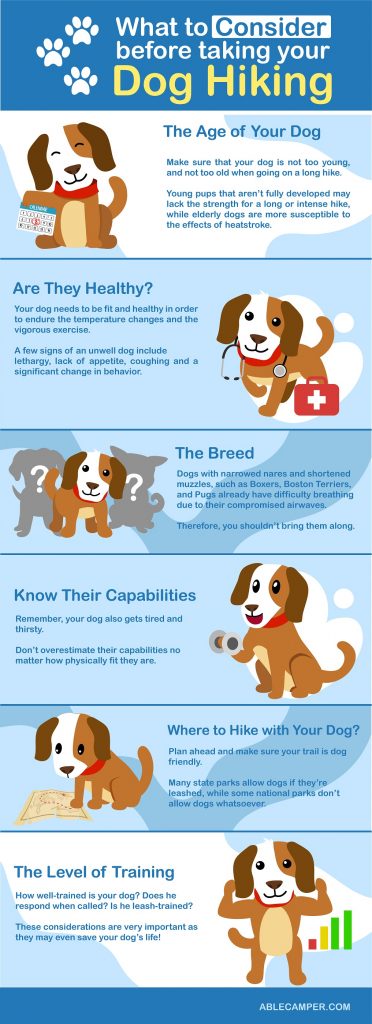
1. The Age of Your Dog
The age of the dog is crucial as it determines how much stamina they have and if they are still growing. Small breeds typically stop growing at around 6 to 8 months of age. While medium breeds take a little longer to reach their adult size at around 12 months of age, with larger dogs extending to 12 to 18 months old.
Young pups that aren’t fully developed may lack the strength for a long or intense hike. Their bones are underdeveloped and this could cause growth problems in the future. Growth plate injuries may also occur and this could result in deformities that would require surgery.
Hiking during warmer months could also pose health risks to elderly dogs as they can’t regulate their body temperatures as well. They’ll ultimately have a hard time with the heat and this could make them more susceptible to the effects of heatstroke.
Elderly dogs have also exhausted their energy levels and get tired pretty fast. That age also comes with other health issues such as arthritis and joint problems which may make hiking a hard task.
Ultimately, make sure that your dog is not too young, and not too old when going on an intense hike. It’s a good idea to ask for your veterinarian’s professional opinion if you are unsure. If you want to take an older dog hiking, make sure the weather is cool and the hike is short with plenty of water sources.
2. Are They Healthy?
Ensure your dog is physically fit and healthy enough to endure the temperature changes and the vigorous exercise. Again, you can visit your vet for a check-up on their fitness level if you are unsure.
The vet may also tell you what measures to take in case of snake bites, stings, and parasites when hiking.
A few ways that you could check the health of your dog yourself, include:
- Fresh Breath. Clean-smelling breath and clean teeth are good signs.
- Skin. Smooth and supple, free of scabs, growths, and rashes.
- Shiny Coat. Clean and shiny coats occur due to natural oils and shedding.
- Eyes. Are they alert? They should no be watering.
- Nose. It should be moist, not very dry or cracked.
- Bowel Movements. They should be free of blood, mucus, and worms.
Signs of a sick dog include a significant change in behavior, lethargy, visible pain, constant vomiting, diarrhea, coughing, lack of appetite, or excessive drinking/urination.
3. The Breed
As touched on previously, elderly dogs have a hard time in warmer months. Similarly, dogs with narrowed nares and shortened muzzles, such as Boxers, Boston Terriers, and Pugs already have difficulty breathing due to their compromised airwaves.
This is commonly referred to as Brachycephalic Obstructive Airway Syndrome (BOAS). Due to the heat, these dogs would start panting quite hard, and consequently, this causes swelling of the tissues in their throat.
According to Susan Nelson (Kansas State University veterinarian), “They then can’t move the air very well and they can quickly succumb to the effects of heat stroke.”
Therefore, it would be best to avoid taking them on long hikes.
4. Know their capabilities
Remember, your dog also gets tired and thirsty. Do not overestimate their capabilities no matter how physically fit they are. Take into consideration the weather, terrain, and temperatures.
Is it too hot, slippery, or is the ground rocky? Will you find enough shade to rest when it gets extremely hot?
5. Where to hike with your dog?
Always ensure that you plan ahead when you intend to bring your dog for a hike as not all hiking trails are dog-friendly! The rules for parks also widely vary.
Dogs are allowed in very limited areas of National parks, or not at all. Whereas many state parks allow dogs as long they’re leashed. Visit www.nps.gov or check out the state parks’ websites to confirm.
When on their website, you should also check for any scheduled renovations, other dog regulations, and any other relevant information.
Other sites where you can find places to hike with your dog include BringFido, Trails, and DogFriendly. You can also check out Best Hikes with Dogs, a book series that provides places where you can hike with a dog in the United States, their leash laws, distance, and popularity.
Being prepared will save yourself from the embarrassment of being sent away if a particular park does not allow dogs.
6. The level of training
How well-trained is your dog? Do they respond when called? Are they leash-trained? These considerations are very important as they may even save your dog’s life.
If your dog is responsive to common commands, you’ll have an easy time when you encounter strangers and other dogs on the trail, especially when they’re off the leash. If they’re not responsive, plan to give them behavior training before you set out.
Obeying your commands such as “stay” will prevent him from scaring other hikers, fighting with other dogs that are on the trail, or tasting a new blend of wildlife poop which could make him sick. More on this later.
How to Prepare for Hiking With Your Dog
As mentioned earlier, it’s essential to prepare before taking your dog hiking. This includes preparing your dog for a long trail, getting prepared yourself, and packing the essential supplies.
So… how exactly do you prepare your dog?
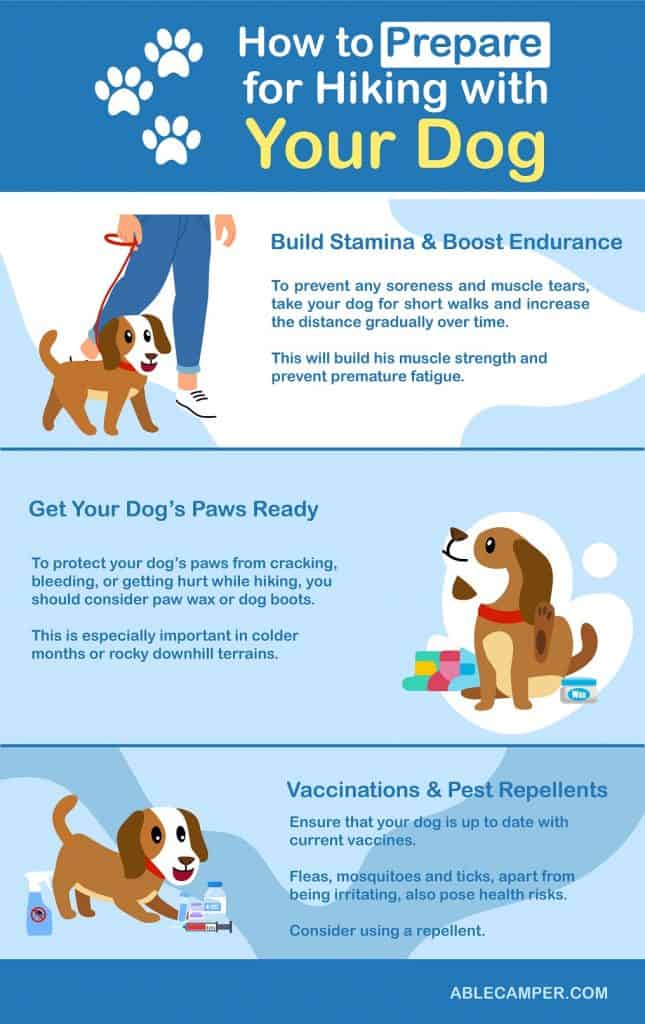
1. Build Stamina & Boost Endurance
Just like you can’t run a marathon without thorough preparation, your dog also needs to build up its stamina and strength needed for the trip. If he’s constantly lounging around the house chewing on pig ears, then there’s no way he’s doing a 15-mile hike the next day.
To prevent any soreness and muscle tears, take your dog for short walks and increase the distance gradually over time. This will build his muscle strength and prevent premature fatigue.
On hot days, consider going for a walk in the morning or at night, when it’s cool. You can also progress to hour-long walks with a small incline and judge the energy levels of your dog.
If your dog stops and lays down, let him rest, and make sure that he has enough water.
2. Get Your Dog’s Paws Ready for Hiking
During winter months, dog paws may experience cracking wherever they are. To combat this and still be able to take your dog’s for walks without worrying about hurting them, common remedies such as Vaseline or cooking spray can help.
To protect your dog’s paws from cracking, bleeding, or getting hurt while hiking, you should consider paw wax or dog boots.
Paw wax and dog boots are more suited for protection against extreme environments such as hot pavement, rough terrain (that you will find when hiking), salt and chemicals, ice build-up, hot sand, and snowballing. You’ll also commonly see sled dogs wearing boots too!
Dog boots offer the best protection and traction, but your dog has to be willing to wear them. Some dogs may experience rubbing (creating raw paws), blisters, or bleeding, while other dogs will love their new little boots.
If your dog has never worn them before, don’t let his first time be on the trail. Let your dog practice and get comfortable with them at home. A few great options are Ruffwear, Muttluks, and Dogbooties.
If your dog doesn’t like boots, you could try paw wax. Musher’s Secret paw wax, for example, provides a dense barrier that forms a breathable bond with your dog’s paws. It’s a great compromise for dog boots.
Keep in mind that every dog is different. What works for your dog, may not work for your friend’s dog. You could take two different dog’s snow hiking for example (with no paw protection), and dog 1 could come back with torn up paws, while dog 2 may not have a scratch on him.
If you think your dog is up for it, you don’t have to apply anything. His paws may even get tougher over time. When you finish the hike, look for any discoloration, tenderness, and swelling. Most of the time, especially during downhill rough terrains or in salty/cold environments, we highly recommend that you add something to your dog’s paws.
3. Vaccinations and Pest Repellents
Ensure that your dog is up to date with current vaccines such as distemper virus, rabies, canine parvovirus, and adenovirus-2. You should also consider vaccinating him against Leptospirosis. It’s caused by bacteria found in water and is spread through the urine of infected animals.
Of course, your dog doesn’t need vaccines for everything. Don’t go overboard. It’s best to get an opinion from your veterinarian. It’s also not a requirement for city dogs to be vaccinated against Leptospirosis. However, your dog can spread this to humans if infected.
You should also try and prevent parasites such as heartworm, ticks, mosquitoes, and fleas. Mosquitoes spread heartworms which are potentially fatal if your dog gets infected. Fleas and ticks, apart from being irritating, also pose health risks.
Pest repellants come in the form of oral, topical, single, or combined options. Some combinations are for fleas and heartworms, while others are for fleas and ticks such as the Caniguard anti-parasite spray. Check the label for the right combination.
Your vet may recommend testing your dog for heartworm first before starting the prevention. Also, you might want to check out an anti-pest collar repellent for prevention against ticks and fleas.
Now that you’ve prepared your dog for the trip ahead, you’ll definitely need some supplies and essential items to carry with you.
What Should You Take With You?
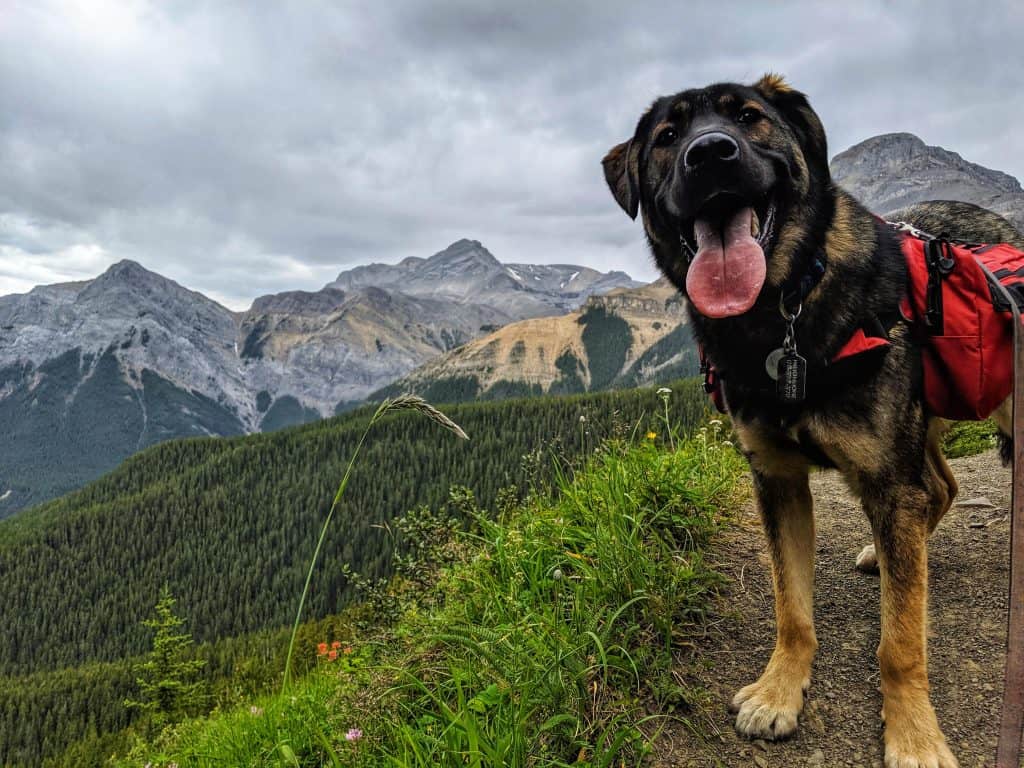
Dog Backpack
These are great as they allow your dog to carry some of their own supplies such as their ball, treats, water, first aid kit, rope, bags, and other essentials.
For most dogs, a backpack weight of 10-12% of your dog’s body weight is ideal. Of course, this can be dependable based on the breed, physical fitness, and energy level of your dog. If you want to add more weight, get the okay from your vet first.
When choosing a backpack, make sure that it has proper padding and that it is specifically designed for dogs. Before making your pick, weigh your dog and measure him up to ensure that the backpack fits when it arrives.
Some dogs can initially be quite resistant which is normal. Let them walk around with an empty backpack at first so that they can get the feel of it.
Then, take your dog for shorter walks and gradually increase the weight. They will need time to develop the extra muscles to handle the additional weight.
Always remember to create a positive association with the backpack and feeding time, or reward them with treats or other pleasurable experiences.
Food
Remember, you have two mouths to feed! Carry dog food for your pup. You can also pack some snacks and dog treats to rekindle their strength and reward them for good behavior.
Protein bars are especially good to boost their energy levels and are easy to pack.
Water
Ensure you carry plenty of water and a collapsible water bowl for your dog to drink from. You don’t want them to suffer heat strokes, so ensure they have enough to drink after every few miles.
Your dog shouldn’t be drinking untreated stream or lake water anywhere, even though he probably loves it! This is due to the risk of contamination by parasites, bacteria and chemicals. The water may be infested with waterborne pathogens (such as Giardia) which will find their way into your dog’s body and possibly make them sick.
If you think the water load will be too much to carry, you can pack a water filter or a water purifier.
Dog First Aid Kit
You never know what may happen when hiking. Your dog may get too jumpy and end up injuring itself. Bring along a travel-size first-aid kit for pets, specifically for dogs. You can also add dog supplies to the general pet kit.
An ideal dog kit will have an antiseptic, antihistamine, blood clotting powder, tick-removal tool, antibiotic ointment, a saline solution, and a first aid guide.
Poop Bags
You should never leave your dog’s poop on the trails. Always pick it and pack them in poop bags or bury it. Follow the pet waste rules of the park or campsite if you’re camping.
If there are trash cans, you can use them (look for ones with lids). If not, ensure you have a larger ziplock plastic bag to put the used bags in until you can comfortably dispose of them.
Sunscreen
If your dog is white-haired, has a light-colored nose, or has short hair, they may need a dog-safe sunscreen to protect them from the sun.
Towel & Pet Wipes
You never know when your dog may dip in water and get themselves wet. Be ready with a towel to dry them and wet wipes to cleanse and groom your pup. You can also leave the towel in your car and wipe him down before you leave.
Cooling Vest
When hiking in hot weather or if your dog has black fur, a cooling vest will protect them from overheating. Just dip the vest in cold water and put it on them.
Booties/Wax
These are to protect your dog’s paws from getting sore and injured on the trail.
Bells/Glow Sticks
If you’re staying the night and camping out, it would be wise to attach a bell to your dog or put a glow stick around his neck, or one tied to his dog pack so that you can locate him.
Training Considerations
Dog Training Behaviors for Hiking
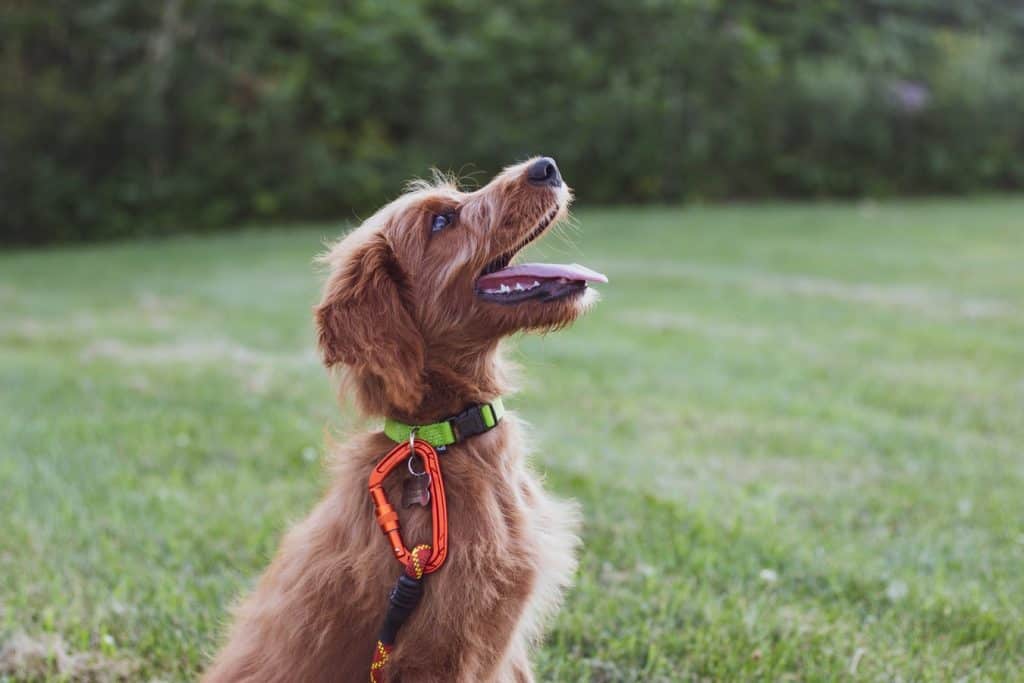
Your dogs should respond to certain commands and have basic training behaviors to help you control them when out and about.
The basic commands that they should respond to are:
- Stay
- Come
- Sit
- Down
- Drop it
- Leave it
They will help keep your dog calm when you come across distractions such as prey, other dogs, items on the way especially for retrievers, and other animals.
These can literally save their life when faced with life-threatening situations like snakes and poisonous plants. You also don’t want your dog running off cliffs. Which leads us to point 2.
Always Leash Your Dog
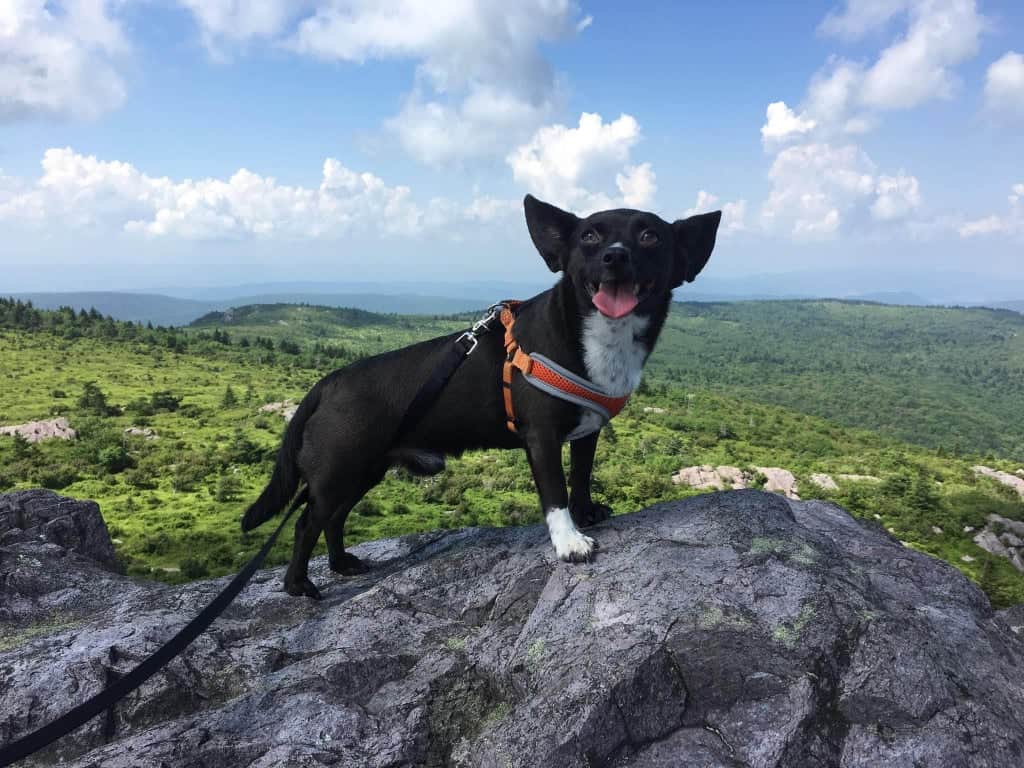
A dog is best on a leash, even when leash-trained. New environments distract dogs easily. They’ll want to sniff everything and chase after birds and insects.
Here are a few reasons to keep your dog leashed:
- A leash limits them from jumping off high ground or into the water and possibly drowning. They may run around and accidentally fall off a ledge.
- A leash will ensure they’re not out of sight, thus they can’t get lost while hiking or get injured without your knowledge.
- Other hikers may have a phobia of dogs (or are allergic to fur), and your very friendly dog may make them nervous!
- If your dog comes across another dog…well, it might not go down too well. One may not like the other. You never know.
- Your dog might destroy other elements in the environment like flowers, native plants, and scare away animals and birds.
You should hook a standard 6-foot long leash to your dog’s harness and never the collar (so you don’t hurt his neck). This is to ensure that you have lots of control in close quarters.
If you have a big dog, or if he weighs more than you, don’t wrap the end of the leash around your hand. If your dog falls, they can take you down with them.
Having your dog wear a name tag with your contact on their collar is never a bad idea. You can even microchip them if you want. In case of separation, you can always locate them.
On the Trail
Trail Etiquette
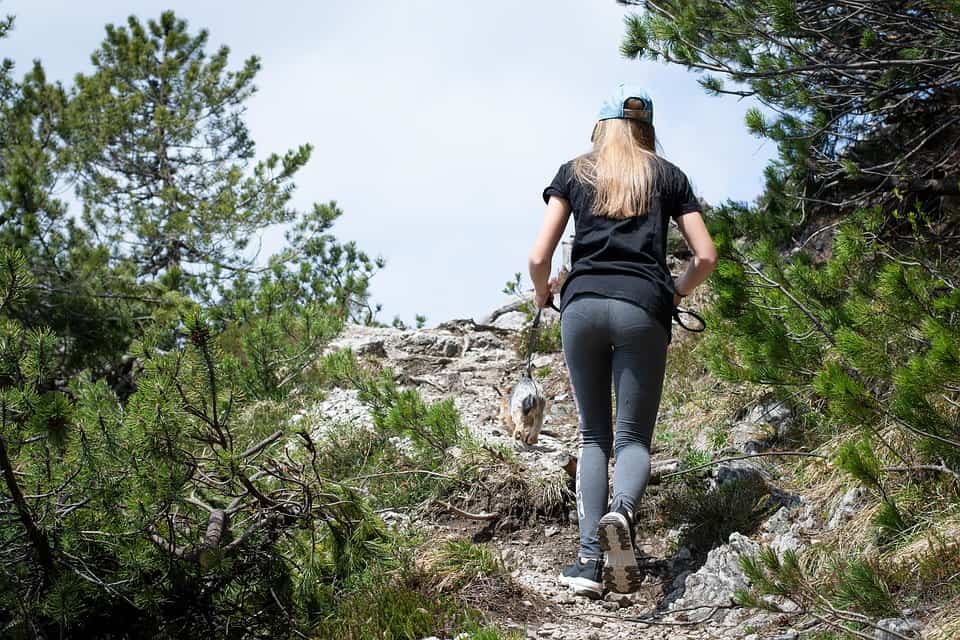
When hiking with your dog, observe trail etiquette by understanding the following:
- You are responsible for your dog’s actions. Have them on a leash and ensure they obey your commands.
- When you come across other people on the trail, especially on a narrow one, you should step aside and let them pass you. Additionally, remember that not all people love dogs, especially strange dogs. They might be afraid of getting sniffed or bitten.
- You and your dog should stick to the trail and make a minimum impact. Avoid cutting switchbacks, making new trails, or taking shortcuts.
- Obey the trail rules such as poop disposal and closed trails.
- Make sure your dog does not destroy the natural features and objects. Do not disturb wildlife like nesting areas.
- If there are horse riders, bikers or cyclists on the trail, keep your dog calm and off the trail and allow the horse to pass.
Dogs can often spook horses, while bikers and cyclists may fall off their bikes as they try to maneuver past your dog. They might even hurt them.
Hazards and What You Should Be Aware Of
Hiking trails harbor a lot of danger for you and your dog, but they can also be a lot of fun! Make sure that you’re aware of hazards and be responsible so that you both return home safe and sound.
Keep an eye out for these dangers:
- Dangerous animals: Some animals threaten both your life and that of your pet. Check out for porcupines and their quills, snakes, coyotes, scorpions, and poisonous spiders.
- Poisonous plants: There are a lot of plants that are toxic to your dog, and some to humans too! From foxglove to black walnuts, don’t let your dog chew on anything that could affect his gastrointestinal tract and his overall health.
- Hunters and Poachers: Whenever your dog is off the leash, let them wear a reflector vest to avoid hunters and poachers from confusing them with another animal. This is mainly recommended in hunting territory.
- Ticks: Ticks can infect your dog with Lyme disease and can cause irritation, rashes, hair loss, and possible skin inflammation. Check for ticks on your dog’s fur regularly and remove them.
- Parasites: Drinking stagnant water and from puddles can have your dog ingest harmful waterborne parasites like worms that will harm their health. Always carry clean water for you and your pup.
- Extreme weather and temperatures: Freezing temperatures, hot weather, ice, and dehydration are a danger to your dog. Keep them warm when it’s cold, out of the sun during the heat, and consider training them to walk with booties (unless it’s hurting them).
- Accidents and injuries: Rough terrain, rocks, cliffs, and steep trails can cause injuries to your dog. If you notice any limping or dragging, you should consider resting or carrying him.
What do you do with dog poop when hiking?
Do not leave your dog’s poop on the trail. Instead, pick it up and pack it in poop bags when you’re hiking. Dog’s poop contains pathogens and parasites that can harm the environment.
Other hikers may come into contact with them or find their way into rivers and lakes. Studies have found 20-30% of bacteria in water samples come from dog waste.
If the park rules allow you to bury the waste, then bury it in a hole that’s 6-8 inches deep and approximately 200ft away from any campsite and water source.
Disposing of waste properly is 1 of the 7 principles of Leave No Trace. You should also read up on the rest.
After the Trip
Check For any Injuries or Ticks
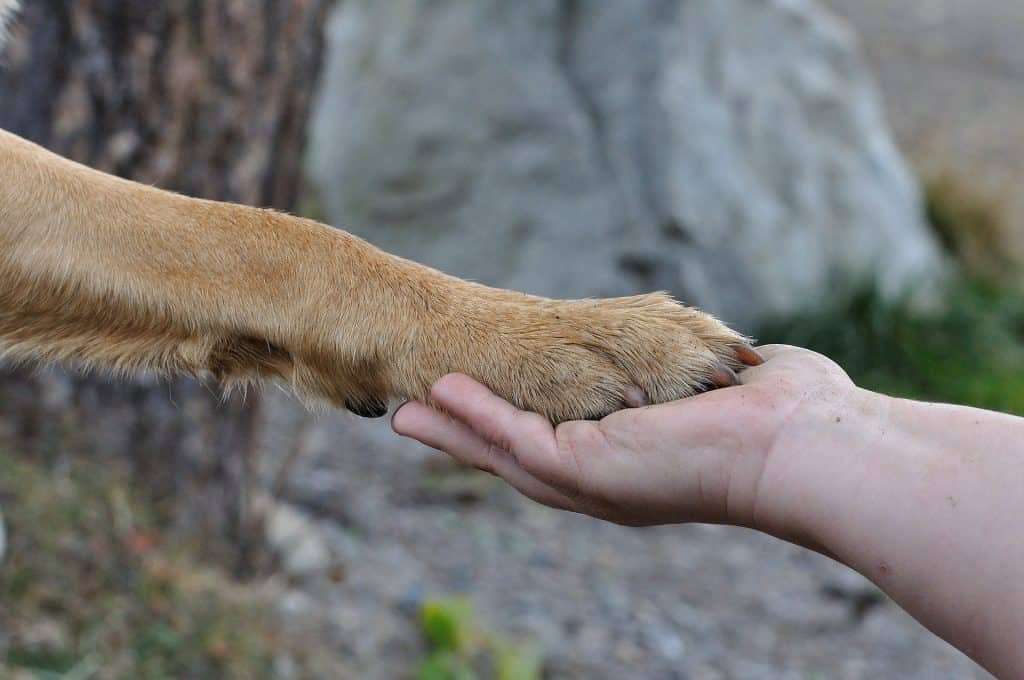
No matter how short your hike was, it’s always advisable to inspect your dog for any injuries or discomfort.
Check their paws, between the toes, around the ears, limbs, and armpits for any sores. Also look out for bite marks, scrapes, inflammation, or other wounds.
Check for ticks, insects, foxtails, and other pests. If there are any, you can remove them by hand or apply a pest repellant on the fur.
You can also give your dog a bath to wash away any dirt, debris, and allergens. The bath will also relax him.
Stretching
After a long day of hiking, always stretch your dog a bit to prevent soreness and muscle fatigue. You can stretch them passively without their knowledge.
Stretch the hip flexors: These muscles enable your dog to move their hips and legs when walking or running. To stretch them, hold your dog’s back leg above the knee when they’re standing, then move it out behind your dog’s body gently and slowly until it’s fully stretched without hurting them. Hold it there for 20 seconds and repeat 2 or 3 times for both back legs.
Stretch the back: You will need dog treats for this stretch. Stand on one side of him and move the treat towards his tail while encouraging your dog to follow it with their eyes. Turning their head only will require them to form a C-shape, stretching their back. Hold them in this position for 10-20 seconds. Do the stretch twice or thrice for both sides.
Stretch the shoulder flexors: These muscles are important for the proper movement of the front legs and fluid. Hold one front leg above the elbow with your other hand below it and move the leg forward slowly as if he’s doing a high-five. When fully stretched out, hold it there for 20-30 seconds and repeat thrice for both legs.
Stretch the chest area: Lay your dog on his back and hold the front legs. Open them up slowly. Keep it like that for a few seconds, then repeat.
Frequently Asked Questions

Can puppies go on hikes?
It is not advisable to take puppies younger than 6 months out for hiking. This is because their growth plates have not yet firmed up and they cannot handle the hot weather.
Big-bodied dogs take longer to mature so the ideal age to start hiking is 18 months. Smaller dogs mature faster and they can start hiking as early as at 9 months.
How far should a puppy hike?
For a pup who is less than a year old, take a few laps around your local park or walk briefly for 10-15 minutes. As they approach 1 year, you can take them for short hikes covering around 2-3 miles in 60 minutes with constant breaks.
What is a dog carrier? Are they bad for dogs?
Dog carriers are similar to backpacks, but they include holes that allow your dog to sit upright with its legs and head hanging out.
It’s a good idea for transporting your dog if they are hurt and can’t work, if they’re tired, or if you’re traveling in a very crowded area.
They are not bad for dogs. They help make trips safe.
How long can a dog hike for?
A lot of factors like a dog’s age, health condition, physical fitness, and breed determine how long a dog can hike for. For active dogs that are healthy, they can comfortably hike for 15-20 miles per day.
Smaller dogs may not have enough energy to hike for long, while other breeds may suffer from heat stroke faster than others. Elderly dogs shouldn’t go for long hikes.
How much weight can a dog carry?
This question is dependable on the dog, with many answers differing. Numerous sources recommend 10-12%, while other sources recommend 25% (such as Peacebonepet). It’s best to ask your vet if you want your dog to carry more than 12%. Factors such as the age and health of your dog can also play a role in how much they can carry.
How do I know if my dog is tired?
If you see your dog drooling, lagging behind, dehydrating, panting rapidly, stalling and losing focus, take a break and allow them to rest and drink some water.
Conclusion
Hiking with your furry friend is enjoyable. Remember to carry the essentials and enough supplies for both of you. You should always make sure it’s safe for them to hike with you and observe the National Parks’ B.A.R.K. rule (Bag your pet’s waste. Always leash your pet. Respect wildlife. Know where you can go) whenever you’re hiking with your dog.
- The 5 Best Heated Vests of 2022 - November 17, 2022
- 5 Best Campfire Cooking Tripods in 2021 - October 20, 2020
- 5 Best Camping Generators (Buying Guide) In 2022 - October 9, 2020






